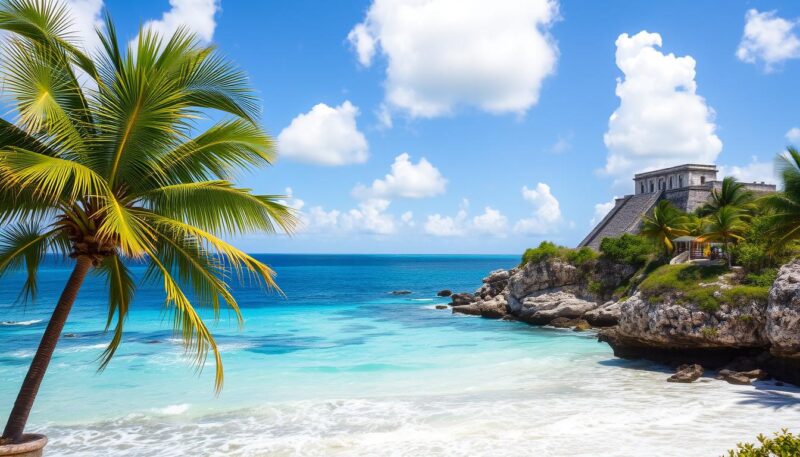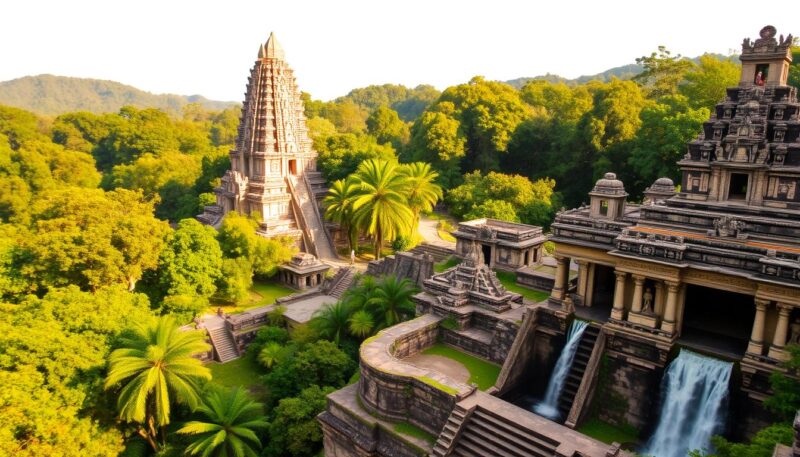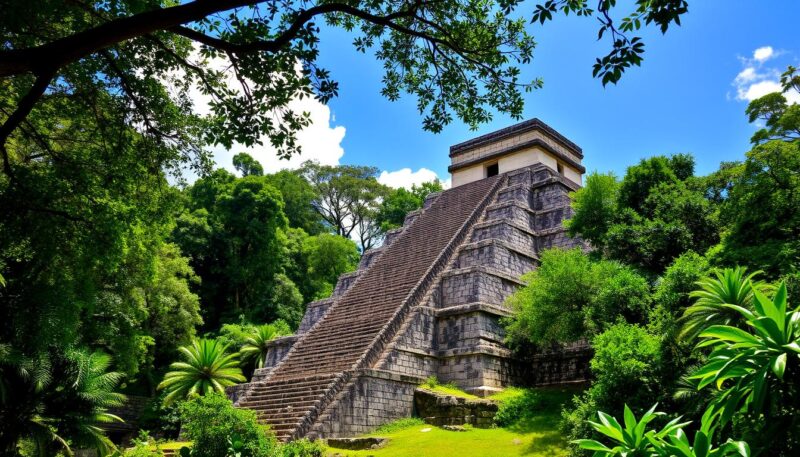Embark on a journey through time as we explore the best Mayan ruins in Mexico, each steeped in rich history and cultural significance. The ancient Maya civilization, flourishing long before the arrival of the Spanish, showcased remarkable advancements in agriculture, mathematics, and astronomy. Today, remnants of this once-mighty culture can be found scattered across the landscape, telling the stories of ancient Mayan cities, their gods, and their complex societies.
This article will guide you through some of the must-see ruins in Mexico, from the magnificent Chichen Itza, designated as one of the New Wonders of the World, to the mesmerizing coastal views of Tulum. These historical sites not only provide a glimpse into the architectural genius of the Maya but also highlight the ecological beauty surrounding each ruin. With over 200 archaeological sites in Mexico alone, we offer practical information for travelers eager to immerse themselves in the wonders of Yucatan archaeology and explore Mayan culture firsthand.
Chichen Itza: The Iconic Mayan Wonder
Chichen Itza stands as a remarkable testament to the grandeur of the Mayan civilization, located in Mexico’s Yucatán Peninsula, approximately 120 miles from Cancun. Designated a UNESCO World Heritage Site and one of the New Seven Wonders of the World, Chichen Itza is often regarded as one of the best ruins for tourists. Over two million visitors flock to this site annually to explore its rich history and stunning architecture.
Historical Significance and Recognition
Chichen Itza’s establishment traces back to around the early 400s A.D., witnessing significant political and economic activity by 600 A.D. It became one of the largest cities in the Mayan world, spanning nearly two square miles and housing a population that peaked at around 50,000 people. The presence of nearly 100 sacbeob, or paved roadways, highlights the city’s sophistication. The Toltecs conquered Chichen Itza in the 10th century, leaving their distinctive architectural influences. Although the city was mostly abandoned by the 15th century, its ruins continue to intrigue historians and visitors alike.
Must-See Highlights
The highlight of Chichen Itza is undoubtedly El Castillo, or the Temple of Kukulkan, a 100-foot pyramid known for its architectural brilliance. Every step of this ancient structure symbolizes a day of the year, demonstrating the Mayans’ advanced calendar system. The Great Ball Court, the largest of its kind in Mesoamerica, measures 168 meters long and highlights the cultural importance of ball games in Mayan society. Visitors can also explore the Sacred Cenote, a site of ritual offerings, which reveals much about the spiritual practices of the civilization.
Visiting Tips
To make the most of your visit to Chichen Itza, plan to arrive early in the morning or late afternoon to avoid peak crowds and heat. The months of March through May are optimal for experiencing pleasant weather. For a more comprehensive experience, consider engaging a private tour guide who can provide deeper insights and even grant access before the official opening times. A visit to Chichen Itza offers a profound glimpse into the brilliance of the ancient Mayans, often bringing comparisons with Tulum, another significant ruin, yet distinct in its coastal allure.
Must-See Ruins Mexico: Exploring Tulum
Tulum stands as a jewel in the crown of the ancient Mayan cities, renowned for its stunning seaside splendor of Tulum. Nestled on the Caribbean coast, this archaeological site not only boasts breathtaking views but also significant historical insights that reveal the depth of Mayan culture.
Unique Coastal Setting
The breathtaking location of Tulum sets it apart from many other historical sites. Perched on cliffs above the turquoise waters of the Caribbean, the ruins offer visitors an unparalleled blend of natural beauty and cultural heritage. Its picturesque beaches are often considered some of the best in Mexico, enhancing the allure of this iconic destination and making it a favorite among tourists.
Historical Insights
As one of the last ancient Mayan cities, Tulum provides a glimpse into the sophistication of the Mayan civilization. The structures here, particularly the Temple of the Descending God and the Temple of the Frescoes, highlight the artistic prowess and cosmological beliefs of the Maya. These buildings are carefully preserved, allowing visitors to appreciate their intricate carvings and murals, which tell stories of the past.
Popular Attractions
- Temple of the Descending God: This iconic structure features a unique sculpture of a deity descending, symbolizing the connection between earth and heaven.
- Temple of the Frescoes: The murals found here depict gods and rituals, providing insights into Mayan mythology.
- Access to pristine beaches: Visitors can enjoy the sun and surf on some of Mexico’s most beautiful beaches, just steps away from the ruins.
For those planning a visit, Tulum travel tips emphasize arriving early to beat crowds and fully immerse in the tranquility and beauty of the site. Its combination of rich history and stunning coastal views cements Tulum’s position as one of the best Mayan sites to explore.

Best Mayan Ruins in Mexico: Palenque and Its Pasitrols
Nestled deep within the lush jungles of Chiapas, Palenque stands as one of the most significant historic sites in Mexico. Known for its architectural marvels of Palenque, this ancient city reveals a spectacular array of temples, pyramids, and intricate hieroglyphics that entice travelers seeking Mayan history travel. Despite the dense jungle that hides much of its grandeur, the site showcases only a fraction of the approximately 15 square kilometers that have yet to be excavated, allowing visitors to glimpse the fascinating world of the Maya.
The Architectural Marvels of Palenque
The ruins at Palenque feature impressive structures that epitomize Mayan ingenuity. The Pyramid of the Inscriptions, rising 89 feet, is a prime example of Mayan architecture. This site not only highlights advanced building techniques but also serves as a tomb for the ancient ruler Pakal. Each building offers unique insights into the social and ceremonial life of the Maya civilization, making it a vital location for those interested in historic sites Mexico.
Ecological and Cultural Importance
Palenque plays a crucial role in biodiversity, surrounded by tropical forests rich in flora and fauna. The dense jungle houses various species, including howler monkeys and toucans, which enhances the experience for visitors. This ecological setting not only supports wildlife but also provides a backdrop for understanding the cultural significance of the Mayan civilization, revealing how they interacted with their environment.
Visiting Recommendations
Exploring Palenque can be an unforgettable experience, especially with some helpful Palenque travel tips. For a more enjoyable visit, consider arriving early in the morning to beat the heat and evade the larger crowds. Entrance fees are around M$35 for the national park, making it an affordable destination for tourists. Be sure to wear comfortable shoes, as navigating the ruins and exploring the extensive pathways can take time and effort.

| Feature | Description |
|---|---|
| Pyramid of the Inscriptions | 89 feet tall, serves as a tomb for King Pakal |
| Total Area | 15 square kilometers, with only 10% excavated |
| Ecological Setting | Tropical forest home to diverse wildlife, including howler monkeys |
| Entrance Fee | Approximately M$35 |
Conclusion
Visiting the best Mayan ruins in Mexico is not just an exploration of ancient architecture; it’s an immersive journey into one of the Americas’ most sophisticated civilizations. Each historic site, such as Chichen Itza, Tulum, and Palenque, offers a unique glimpse into the cultural tapestry of the ancient Maya. Chichen Itza, with its iconic El Castillo, supported a thriving population of up to 50,000 at its peak and is recognized as one of the New Seven Wonders of the World. Similarly, the coastal beauty of Tulum attracts millions of visitors annually, making it a crucial part of any Mexico travel guide.
Palenque, at its zenith between 500 and 700 CE, is a treasure trove of archaeological wonders, with only 10% of its mysteries uncovered, leaving much to explore. Other sites like Coba and Uxmal further enrich the narrative of ancient Mayan cities, showcasing impressive structures and vibrant heritage. As you plan your visit, remember that the best time to experience these historic sites in Mexico is during the dry season, from November to April, ensuring a comfortable and enjoyable journey.
The allure of these sites continues to captivate history enthusiasts and travelers alike, making them essential stops on any itinerary focused on the rich legacy of the Maya. Whether you’re standing before the towering pyramids of Coba or gazing at the murals of Bonampak, each moment spent at these ruins deepens your understanding of a culture that thrived in the heart of Mesoamerica.

